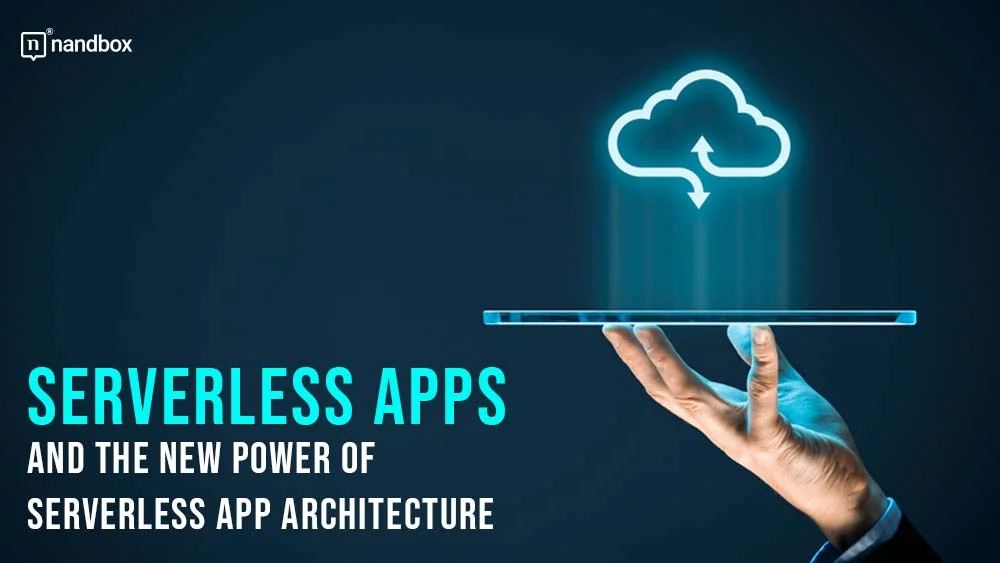Serverless App Architecture: Revolutionizing the Future of Cloud Computing
The world of cloud computing is dynamic—so dynamic that you can’t sleep on it for even a fraction of a second. Each minute and second means a new solution and development method made to make the process better and more convenient. With this, many businesses and app owners find it difficult to keep up with all the new methodologies, tools, and solutions that they need to adapt to. There has to be some way. But how could they find a way to both develop and run applications effectively and in no time? Surprisingly, being dynamic is not bad after all. In this article, we will introduce you to the latest app development solution: serverless app architecture, and how you could ultimately benefit from serverless apps.
What Is the Serverless App Architecture?
The process of app development is a vast one. We can pretty much say that it is a mega process with many other branches branching from it, which in the end makes a fully functional app. However, the rise of cloud computing somewhat transformed this process and made it much more advanced and progressed. For instance, the thing started with cloud servers where developers could store and maintain their data safely and efficiently. The new solutions were only limited to storage and some other things, like APIs. However, the rest was usually covered by developers, like maintaining, running, and creating the app infrastructure. Now let us focus on the app infrastructure for a bit.
An app’s infrastructure is all the operational components and elements needed to make app development, deployment, and overall management possible. And since the design of an app infrastructure is not a simple process, a solution was there to help.
Serverless apps architecture is a way of managing and running apps and their servers without needing to design an infrastructure. But how is that? Usually, applications now run on servers. In the case of serverless architecture, a cloud provider offers an already-established infrastructure. This saves developers both money and the effort of configuring and managing an infrastructure from scratch.
The Main Elements of Serverless App Architecture
1.) Function as a Service
The first and main element of serverless apps architecture is function as a service, or FaaS. A FaaS is a part that allows developers to write and configure their app codes and functions. This includes users’ actions and the triggers that these functions will respond to.
2.) Client Interface
The client or user interface is another major element of a serverless apps architecture. This interface is responsible for taking in and receiving requests from users. This interface has to be as flexible and dynamic as possible, as the number and nature of requests vary from time to time.
3.) Cloud Server
Just like any application, there has to be somewhere where all the users’ requests are handled and hosted. In this case, the cloud server is here to serve. On this server, all the app data would be present and stored to respond to any user request or action.
4.) Security
Security is always a key to any app architecture method, so it is no surprise that it is a major element here. This element includes encompassing authentication, authorization, and all necessary security measures that could protect all functions and codes to a maximized level.
5.) Backend Service
This element refers to various backend services that serverless apps often interact with, such as databases, storage services, message queues, and external APIs. Serverless functions can make use of these services to store data, send notifications, and perform other tasks.
6.) API Gateway
In fact, APIs are a crucial part of many serverless architectures. The AWS API Gateway is one example of an API Gateway that may be used to manage and direct HTTP requests to the proper serverless functions. They are also able to manage security measures like authentication, authorization, and managing requests and responses.
Serverless Architecture and IoT
IoT is now taking over the world and being a part of all applications, software, and even devices. Since the Internet of Things is all about exchanging data and handling incoming requests and communications among devices, it needs a solution that makes it possible to do so. That is why serverless architecture is considered to be the best companion for IoT. I mean, think about a better duo, well, after Cher and Bono. Exactly, nothing. The dynamic and flexible nature of serverless architecture makes it much easier for IoT devices and apps to communicate and handle as many high volumes of data exchange requests. This certainly leads to better performance and reliability.
Exploring the Benefits and Challenges of Serverless App Architecture
Advantages
Cost Efficiency
With serverless computing, you only pay for the processing capacity and power you really need. In particular, for applications with dynamic workloads, the elimination of the requirement to supply and maintain servers can lead to significant cost savings that would be a great benefit in the long term for businesses.
Scalability
With serverless app architectures, scalability is handled automatically in response to changes in user demand. Automatically scaling to meet peak demand means you never have to worry about your app failing due to a downturn in usage.
Reduced Operational Overhead
Since there are no physical servers on your end, you can pass off much of the administration tasks to your cloud service provider. This means less time spent on administrative duties like server upkeep and software updates.
Faster Time-to-Market
Developers no longer have to spend time managing infrastructure and can instead concentrate on creating new code and features. This would not only help improve and enhance apps in terms of features but also save time on the whole development process.
Automatic High Availability
In most cases, high availability is a standard feature of serverless platforms. By automatically distributing functions among cloud servers or infrastructures, we can lessen the likelihood of service interruptions and outages that can cause user frustration and dissatisfaction.
Challenges
Lack of Control Over Infrastructure
Since serverless computing takes the underlying infrastructure away, it leaves you with much less control over how your servers are set up and how they might be optimized. When you need precise settings or low-level optimizations for your program, this lack of command can be a major issue.
Testing Challenges
The assessment of serverless functions can be more difficult, especially when those functions have interconnections with other systems, such as databases or other web services. It may be challenging to efficiently simulate these correlations during testing.
Monitoring and Debugging Complexity
Even though serverless solutions provide monitoring tools, it might be challenging to address complicated problems in a distributed and serverless architecture design. Understanding the sequence of functions and tracking the progression of events are two of the main aspects that developers might struggle with.
Long-Term Cost Concerns
Several scenarios can benefit from the low upfront costs of serverless app architecture, but as applications grow, such savings may not be sustainable. As your application develops, it is crucial that you keep an eye on costs and find ways to reduce them.
Resource Constraints
Functions, including their runtime and memory, are subject to constraints set by serverless platforms. This may be a problem for workloads that need to run for a long time or that require a substantial amount of processing power.
Security Concerns
Although serverless solutions take care of some security concerns, developers should always keep safe practices in mind. Vulnerabilities in system security might result from improperly established privileges or overly permissive roles found in serverless platforms.
Use Cases That Prove the Effectiveness of Serverless App Architecture
Although the term might sound brand new, serverless apps architecture has made an appearance on multiple platforms and applications. This helped such a method prove its major effectiveness and encouraged people to start considering it. Here are two of the most popular use cases of serverless app architecture that might inspire you!
Netflix
Netflix is one of the greatest use cases that took good advantage of serverless app architecture. The app has millions of users, so it is no surprise that it receives an enormous number of requests per day. Therefore, they needed to shift to a more stable and flexible infrastructure that made handling these requests easier. That is why the app and platform started using serverless computing and app architecture since this solution is known for great scalability, as we mentioned before. This provided Netflix with a great edge of being highly available and dynamic, as they can now repose and handle whatever number of requests they might get.
Slack
Slack is a famous communications app and software that is known for being the go-to for many organizations. What Slack did with serverless app architecture was very smart and helped them operate better. Since Slack usually relies on chatbots, they consider them single-function applications. These single-function applications can then run on serverless architectures, where they can handle as many requests as possible. So now you know that all Slack chatbots run on serverless servers and architectures, specifically AWS Lambda.
En Fin
With the huge and massive demand that the app market is witnessing, serverless architecture comes as a knight in shining armor. In addition to being highly adaptable and flexible, serverless app architecture also gives a business or an app the edge in adopting such an advanced method. Such an edge can be a major attraction for users and lead to astonishing outcomes. There are many methods other serverless app architectures have left unveiled and many more to come soon, which leaves us to expect nothing but a promising future for app development.








